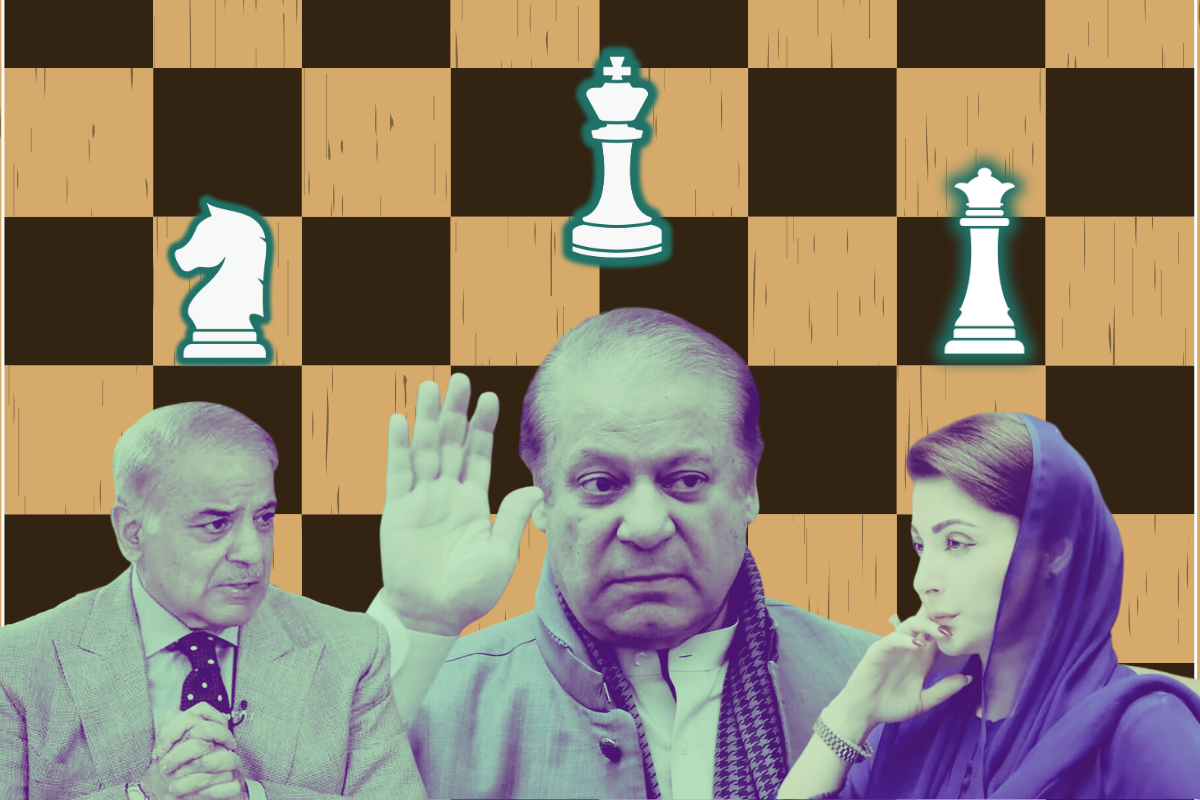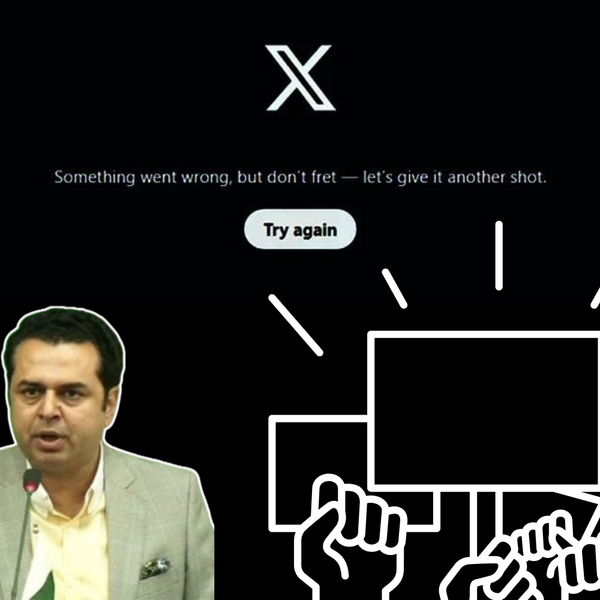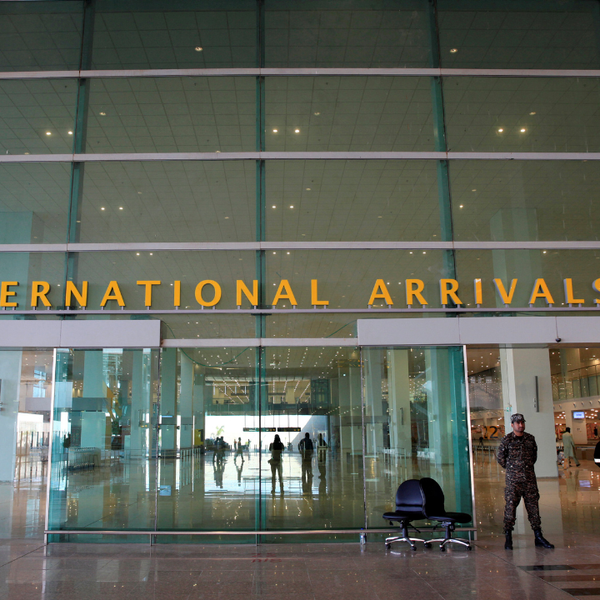What is Nawaz Sharif up to?
The three-time former premier has time on his side but this is an unfavorable era for dynastic politics
Zaigham Khan
Guest Contributor
Zaigham Khan is a senior journalist and analyst with a degree in Social Anthropology from the University of London.

Nawaz Sharif with his brother and PM Shehbaz Sharif, and daughter and Punjab CM Maryam Nawaz.
Nukta
Nawaz Sharif has an expressive face that rarely conceals his emotions. Yet, his true intentions and plans remain elusive, often leading his opponents to miscalculate and make costly mistakes.
As the Quaid (Supreme Leader) of the ruling Pakistan Muslim League-Nawaz (PML-N), he wields absolute authority, with veto power over all party decisions. His choices have shaped the political landscape in Islamabad and Punjab.
Despite this dominance over the current political landscape, he remains strikingly inaccessible—not just to the media but even to the top PML-N leadership. He appears at his discretion, only to vanish for extended periods, leaving many wondering: What is he up to?
When the PML-N entered the 2024 elections, it campaigned under the slogan "Mulk ko Nawaz do", which literally translates to "Give Nawaz to the country." However, the phrase also carried a clever pun, as "Nawaz" means "to bless," making the slogan simultaneously convey: "Bless Pakistan" or "Bless Pakistan with Nawaz Sharif."
Despite this strong messaging to mobilize PML-N voters, while forming a coalition government following the controversial elections, Nawaz Sharif declined the prime ministership, citing a limited mandate as his reason. Instead, he appointed his brother, Shehbaz Sharif, as prime minister, while his daughter, Maryam Nawaz, assumed the powerful position of chief minister of Punjab province.
Did Nawaz Sharif ever truly want another term, or is the current situation unfolding exactly as he planned? Even during his last tenure in office, he seemed disinterested in the role he had already held twice. He had delegated most of his responsibilities to his two key deputies, Ishaq Dar and Chaudhry Nisar, while much of the party’s political maneuvering was outsourced to his deputies. Throughout his time in power, he remained largely inaccessible—not only to party leaders but even to federal ministers.
During this period, Nawaz Sharif began grooming his daughter, Maryam Nawaz, as his political successor. However, the powerful establishment had turned against him, and amid other challenges, her path to succession was obstructed through judicial actions and media narratives.
When Maryam Nawaz was appointed the chairperson of the Prime Minister's Youth Loan Programme, the Lahore High Court declared that her appointment was made “without adherence to the principles of fairness, transparency, and merit” in 2014. She was later put in charge of the PML-N media cell, which found itself in constant conflict with the Pakistan Tehreek-e-Insaf's (PTI) powerful media machinery, which, at the time, received strong backing from the media wings of the secret services.
Given Nawaz Sharif’s age and health, the PML-N’s current tenure was likely his last opportunity to firmly place Maryam Nawaz on the path to succession. Even before 2024, it was not difficult to discern that elevating Maryam Nawaz was the PML-N supremo's primary agenda. However, given the family dynamics, it would have been challenging for him to assume the Prime Minister’s Office while simultaneously handing over control of Pakistan’s most populous province to his daughter, neglecting his brother, Shehbaz Sharif, and his sons.
Over the past year, Nawaz Sharif’s political focus has seemingly revolved around a single objective: consolidating Maryam Nawaz’s power—winning hearts and minds in Punjab and paving the way for her to become prime minister. Almost all of his political activities can be explained in this context.
This is a key reason why he and his party have been cautious in avoiding direct conflict with the establishment this time. Any confrontation could fatally disrupt the delicate process of succession at this critical juncture. It is also why Nawaz Sharif has supported strong-handed tactics against the PTI, the primary challenger to Maryam Nawaz. Sensing this, the PTI has intensified its attacks on Maryam Nawaz in ways it never has before.
Like royalty, political dynasties groom their electable princes for their prospective roles. Zulfiqar Ali Bhutto could not personally oversee the process of succession. However, he had amply prepared his daughter Benazir Bhutto for it through the best education and excellent political grooming.
Though Nawaz Sharif has time on his side, this is an unfavorable era for dynastic politics—both in South Asia, a historical stronghold of political dynasties, and globally. Populist movements across the world are challenging the hereditary right to rule, and the youth are increasingly wary of such entitlement. The Nehru dynasty in neighboring India is out of power with no imminent chance of returning. Hasina Wajid has been forced to flee her country. The Bhutto dynasty has been relegated to rural Sindh.
Only time will tell if Maryam Nawaz can weather the socio-political storms and transform her father’s legacy into a formidable dynasty with his support. However, Nawaz Sharif’s opponents would be unwise to take his ambitions at face value.
* Zaigham Khan is a senior journalist and analyst with a degree in Social Anthropology from the University of London.
* The views and opinions expressed in this article are those of the author and do not necessarily reflect the editorial stance of Nukta.







Comments
See what people are discussing